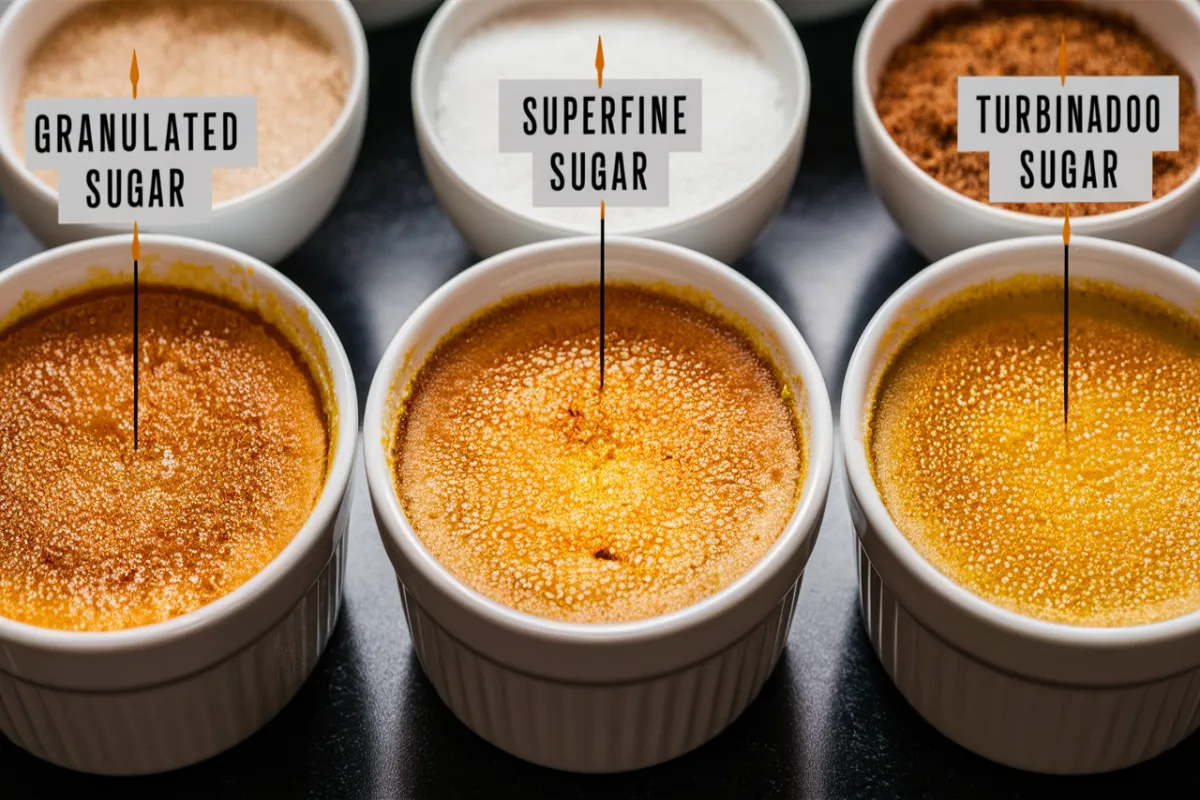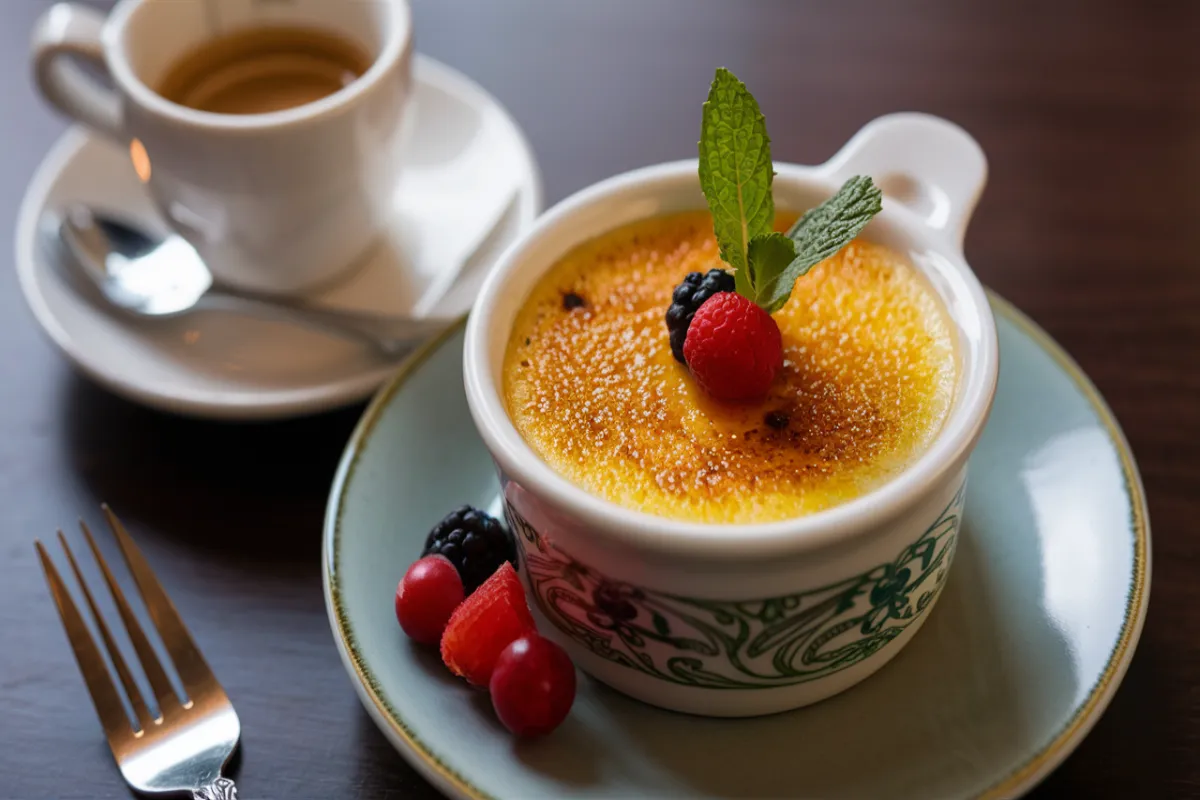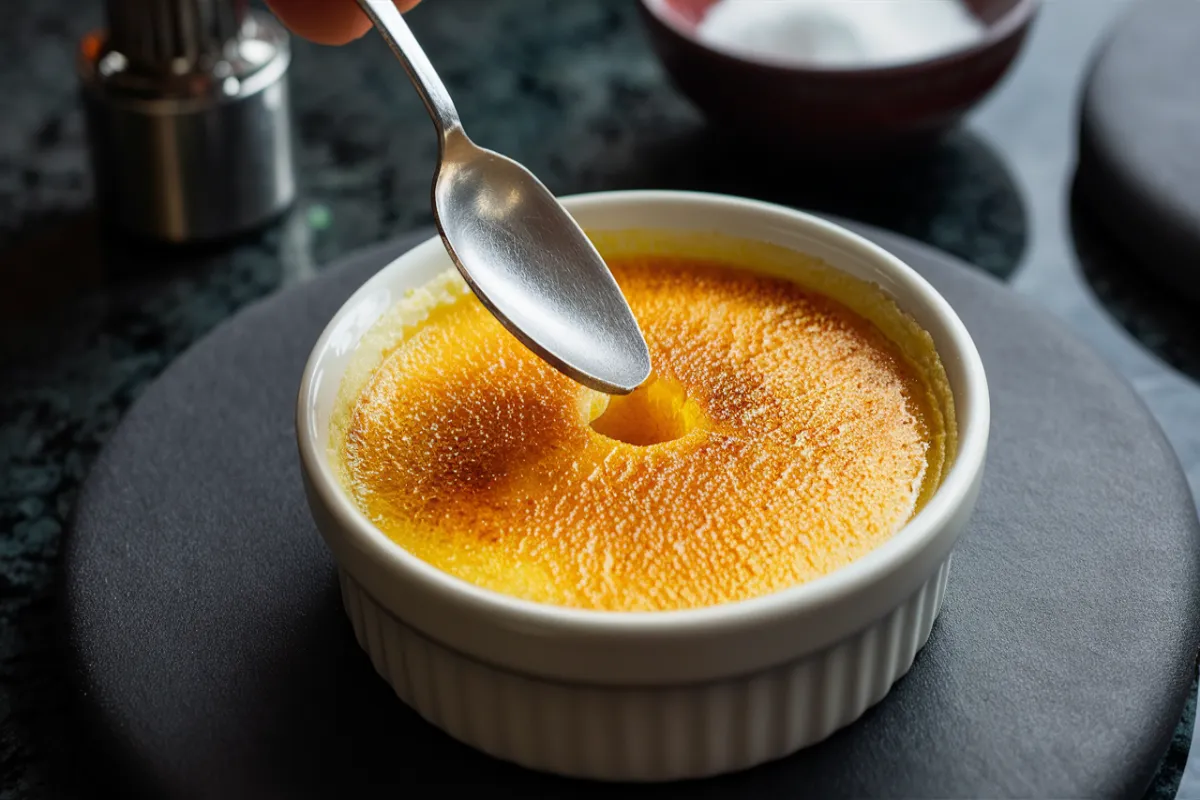Achieving a perfect, crunchy top on crème brûlée is what elevates this classic dessert to its iconic status. The contrast between the creamy custard and the caramelized sugar topping defines the dish. Yet, getting that top to crack just right requires skill and precision. In this comprehensive guide, I will show you how to create a flawless, crunchy top on crème brûlée. From choosing the right sugar to mastering caramelization techniques, I’ll cover everything you need to know.
1. Understanding the Basics of Crème Brûlée
1.1 What Makes a Crunchy Top?
The hallmark of crème brûlée lies in its crisp, caramelized top. This layer forms when sugar is heated until it melts and hardens into a thin, brittle crust. The crunch contrasts with the smooth custard below, creating a textural delight. The sugar you choose, the way you apply it, and the method of caramelization all impact the final result.
1.2 Why the Right Sugar Matters
Not all sugars are created equal when it comes to creating that perfect crunchy top on crème brûlée. Granulated white sugar is the go-to choice because it melts evenly and forms a clear, crackling surface. Other sugars like turbinado or demerara can add a unique crunch and flavor, but they require careful handling to achieve that ideal crunchy top on crème brûlée. Understanding how each sugar behaves under heat is crucial to achieving the desired texture.
1.3 The Importance of Even Caramelization
Even caramelization ensures that the entire surface of your crème brûlée has a uniform crunch. This requires evenly distributed sugar and precise control over the heat source. Uneven caramelization can result in a patchy, inconsistent crust that detracts from the dessert’s overall appeal. The key is to achieve a smooth, golden-brown layer that cracks perfectly under the spoon.
2. Choosing the Right Sugar for a Crunchy Top

2.1 Granulated White Sugar: The Standard Choice
Granulated white sugar is the most commonly used sugar for crème brûlée. Its fine crystals spread evenly and melt quickly, forming a smooth, glass-like crust. This sugar caramelizes at a lower temperature, allowing you to control the process easily. For beginners and traditionalists, granulated sugar offers the best combination of simplicity and effectiveness.
2.2 Superfine Sugar: For a Delicate Crust
Superfine sugar, also known as caster sugar, has smaller crystals than granulated sugar. This sugar dissolves more quickly, creating a thinner, more delicate crust. Superfine sugar is ideal if you prefer a lighter, more refined topping. However, because it caramelizes quickly, you must pay close attention during the process to avoid burning.
2.3 Turbinado and Demerara Sugar: For Extra Crunch
Turbinado and demerara sugars have larger crystals and a natural molasses flavor. These sugars add an extra crunch and a deeper caramel flavor, contributing to a perfectly crunchy top on crème brûlée. However, their larger crystals require more time and heat to caramelize properly, which is essential for achieving a satisfying crunchy top on crème brûlée. The result is a thicker, more textured crust that offers a satisfying bite. For those who enjoy a robust, earthy flavor, these sugars provide a unique twist on the classic brûlée.
2.4 Blending Sugars: Customizing Texture and Flavor
Blending different types of sugar can help you achieve a custom texture and flavor. For example, mixing granulated sugar with a small amount of turbinado sugar creates a topping that’s both smooth and crunchy. This approach allows you to experiment with different textures, creating a brûlée that suits your personal taste. However, blending sugars requires careful monitoring during caramelization to ensure even melting and browning.
Understanding Texture in Visual Design
3. Preparing the Crème Brûlée for Caramelization
3.1 Chilling the Custard Thoroughly
Before you begin caramelizing the sugar, ensure that the custard is fully set and chilled to help create that desired crunchy top on crème brûlée. A well-chilled custard withstands the heat from the torch or broiler, preventing it from melting or becoming too soft. Chill the custard in the refrigerator for at least two hours, or until it’s firm to the touch. This step is crucial for maintaining the creamy texture of the custard while achieving a perfect crunchy top on crème brûlée.
3.2 Applying the Sugar Evenly
Even sugar distribution is key to achieving a uniform caramelized crust. Use about one to two teaspoons of sugar per ramekin. Sprinkle the sugar in an even layer over the surface of the custard. Tilt and rotate the ramekin to ensure the sugar covers the entire surface evenly. This technique prevents any areas from caramelizing too quickly or too slowly, resulting in a smooth, consistent crunch.
3.3 Adjusting the Sugar Layer Thickness
The thickness of the sugar layer affects how the top caramelizes and cracks. A thin layer of sugar creates a delicate crust that’s easy to crack but may lack the satisfying crunch some prefer. A thicker layer provides a more robust crunch but requires careful caramelization to avoid burning. Adjust the thickness based on your preference, and ensure even coverage to achieve the best results.
3.4 Removing Excess Moisture
Moisture on the custard’s surface can interfere with achieving a crunchy top on crème brûlée. Before applying the sugar, gently blot any moisture from the custard with a paper towel. This step ensures that the sugar remains dry, helping it melt evenly and form a crunchy top on crème brûlée. Excess moisture can cause the sugar to dissolve before it caramelizes, leading to an uneven or soggy crust.
4. Caramelization Techniques for a Perfect Crunch
4.1 Using a Culinary Torch: The Preferred Method
A culinary torch is the most effective tool for caramelizing the sugar on crème brûlée. Hold the torch about 4 to 6 inches above the sugar surface and move it in small, circular motions. Begin at the edges and work your way inward to ensure even caramelization. The torch allows you to control the heat precisely, ensuring that the sugar melts and browns without overheating the custard.
4.2 Adjusting the Torch Flame
The flame setting on your torch plays a critical role in caramelization. A medium flame provides enough heat to melt the sugar evenly without burning it. If the flame is too low, the sugar may caramelize unevenly or take too long, risking the integrity of the custard. If too high, it can burn the sugar quickly, resulting in a bitter taste. Adjust the flame based on the sugar’s response to ensure a perfect, crunchy top.
4.3 Caramelizing Under a Broiler: An Alternative Method
If you don’t have a culinary torch, you can use your oven’s broiler to caramelize the sugar. Preheat the broiler and place the ramekins on the top rack, close to the heat source. Keep the oven door slightly open to monitor the caramelization process. The sugar should melt and caramelize within 2 to 3 minutes. However, the broiler method can heat the custard, so it’s important to use a very cold custard base to minimize this effect.
4.4 Achieving Even Caramelization
Even caramelization is essential for a consistent, crunchy top. Whether using a torch or broiler, move the heat source constantly to avoid concentrating too much heat in one spot. Watch the sugar as it melts and browns, and adjust the heat as needed to ensure an even caramelization. The goal is to achieve a deep golden-brown color across the entire surface.
5. Enhancing Flavor and Texture

5.1 Adding Spices to the Sugar
Adding spices to the sugar before caramelizing can enhance the flavor of your brûlée. A pinch of cinnamon, nutmeg, or cardamom can add warmth and complexity to the topping. Mix the spices with the sugar before sprinkling it over the custard. The spices will caramelize along with the sugar, infusing the brûlée with subtle, aromatic flavors.
5.2 Using Flavored Sugars
Flavored sugars offer a creative way to add depth to your crème brûlée. Vanilla sugar, for example, adds a rich, aromatic note to the topping. To make flavored sugar, mix granulated sugar with vanilla beans, citrus zest, or spices and let it sit for a few days. Use this sugar to caramelize your brûlée for a unique twist on the classic dessert.
5.3 Blending Sugars for Custom Texture
Blending different sugars can create a more complex texture and flavor. For instance, mixing granulated sugar with a small amount of turbinado or demerara sugar adds crunch and a hint of molasses. This combination produces a topping that’s both smooth and textured, offering a more interesting contrast with the creamy custard.
5.4 Experimenting with Non-Traditional Sugars
Experimenting with non-traditional sugars can lead to exciting new flavor profiles. Coconut sugar, for example, adds a subtle coconut flavor and caramelizes to a deep brown color. Maple sugar offers a rich, earthy sweetness that pairs beautifully with the custard. When using alternative sugars, adjust the caramelization time to prevent burning, as these sugars may behave differently under heat.
6. Tips for Perfecting Your Crème Brûlée
6.1 Avoiding Overcaramelization
Overcaramelization can lead to a burnt, bitter crust. To avoid this, keep the torch moving constantly and monitor the color of the sugar closely. The goal is to achieve a deep golden-brown color without letting the sugar turn too dark. If using a broiler, remove the ramekins as soon as the sugar has caramelized to prevent overheating.
6.2 Letting the Sugar Harden
After caramelizing, allow the sugar to harden for a minute or two before serving. This short resting period lets the sugar cool and form a brittle, crackling layer. Avoid refrigerating the brûlée after caramelization, as this can cause the sugar to soften and lose its crispness. Serve the brûlée immediately for the best texture.
6.3 Serving Crème Brûlée
Serve crème brûlée in shallow ramekins to ensure a good ratio of custard to caramelized sugar. The shallow depth allows for a larger surface area, providing more room for the caramelized topping. Pair the brûlée with fresh berries, a dollop of whipped cream, or a drizzle of fruit sauce to add contrast and enhance the dessert’s presentation.
6.4 Storing Leftovers
While crème brûlée is best enjoyed fresh, you can store leftovers in the refrigerator for up to two days. Cover the dishes with plastic wrap, but avoid touching the caramelized surface, as this can cause it to soften. When ready to serve, let the brûlée sit at room temperature for a few minutes to allow the sugar to re-harden.
7. Common Mistakes to Avoid
7.1 Using the Wrong Sugar
Choosing the wrong sugar can affect the texture and flavor of your brûlée. Avoid using powdered sugar, as it may contain cornstarch, which can prevent proper caramelization. Stick to granulated, superfine, turbinado, or demerara sugars for the best results. Each of these sugars caramelizes well and contributes to the desired crunchy texture.
7.2 Applying Too Much or Too Little Sugar
The amount of sugar you apply directly impacts the quality of the caramelized crust. Too much sugar can create a thick, hard layer that’s difficult to crack, while too little may result in a thin, unsatisfying crust. Aim for a thin, even layer that covers the custard completely. This balance ensures a crisp, crackable top that enhances the dessert.
7.3 Holding the Torch Too Close
Holding the torch too close to the sugar can burn it quickly, leaving a bitter taste and an uneven crust. Keep the torch at least 4 to 6 inches away from the sugar and move it constantly to prevent burning. The goal is to melt and caramelize the sugar gradually, allowing it to form a smooth, even crust.
7.4 Overheating the Custard
Overheating the custard can cause it to lose its creamy texture. This issue often occurs when using a broiler or holding the torch too close for too long. To avoid overheating, use a well-chilled custard base and apply the heat gradually. If using a broiler, keep the oven door slightly open and monitor the caramelization process closely.
8. Enhancing Your Crème Brûlée Experience
8.1 Pairing with Complementary Flavors
Pairing your crème brûlée with complementary flavors can elevate the dessert. Fresh berries, such as raspberries or blueberries, add a burst of tartness that contrasts with the sweet, creamy custard. A drizzle of caramel or chocolate sauce can also enhance the richness of the brûlée. For a more sophisticated touch, serve the dessert with a glass of dessert wine or a cup of strong espresso.
8.2 Customizing with Flavor Infusions
Infusing the custard with flavors can add depth to your crème brûlée. For example, steep vanilla beans, citrus zest, or spices in the cream before making the custard. These flavors will permeate the custard, adding complexity to each bite. Infused custards pair beautifully with the caramelized sugar topping, creating a more nuanced dessert.
8.3 Experimenting with Different Sugars
Experimenting with different sugars allows you to tailor the brûlée to your taste, especially when aiming for that perfect crunchy top on crème brûlée. Try using flavored sugars or blending sugars to create a unique topping that enhances the crunchy top on crème brûlée. Each type of sugar offers a different texture and flavor, from the smoothness of granulated sugar to the crunch of turbinado. By experimenting, you can discover the perfect sugar combination that complements your custard.
8.4 Presenting Crème Brûlée Elegantly
Presentation plays a crucial role in the enjoyment of crème brûlée. To highlight the crunchy top on crème brûlée, serve the dessert in elegant ramekins or shallow dishes that showcase the caramelized topping. Garnish with a sprig of mint, a few fresh berries, or a dusting of powdered sugar for a finishing touch. The goal is to create a visually appealing dessert that invites your guests to crack through the crunchy top on crème brûlée and savor the creamy custard beneath.
9. Frequently Asked Questions
9.1 Which Sugar Works Best for a Crunchy Crust?
Granulated white sugar is the standard choice for a smooth, crunchy crust. However, turbinado and demerara sugars offer extra crunch and flavor.
9.2 Can I Use a Broiler Instead of a Torch?
Yes, you can use a broiler to caramelize the sugar. Place the ramekins close to the heat source and monitor them closely to prevent burning.
9.3 How Do I Know When the Sugar Is Perfectly Caramelized?
The sugar should turn a deep golden-brown and form a smooth, glossy surface. Avoid letting it darken too much, as this can result in a bitter taste.
9.4 How Thick Should the Sugar Layer Be?
A thin, even layer of sugar works best. Typically, one to two teaspoons per ramekin creates a perfect, crackable crust.
9.5 What Can I Do If the Sugar Doesn’t Caramelize Evenly?
If the sugar doesn’t caramelize evenly, use the torch to lightly pass over any uncaramelized spots. Ensure the sugar layer is thin and even before starting.
Conclusion
Getting a crunchy top on crème brûlée requires attention to detail, the right sugar, and precise caramelization techniques. By choosing the best sugar, applying it evenly, and using the correct tools, you can achieve that iconic, crackling crust. Whether you stick to traditional methods or experiment with new flavors and sugars, the result will be a crème brûlée that’s both visually stunning and delicious. Enjoy the satisfaction of cracking through the golden topping to reveal the creamy custard beneath, and savor every bite of this timeless dessert.

